The first modern Chilean Ironclad: Capitán Prat was one of the reasons behind the Chile-Argentina 1890s naval arms race. Built in France in 1889-91, this first steel-hulled ironclad of the Chilean Navy was also the world’s first battleship equipped with an electrical system. Typical of French battleships of the time, albeit smaller she ported four 9.4 in (240 mm) guns in four single turrets, in the typical lozenge pattern, and a tumblehome. Prior to the war of 1898, the US Navy approached Chile to purchase her and bolster its forces (as Japan in 1903). Capitan Prat was modernized in 1909–1910 and became a coast defence ship from 1926, sub-tender in 1930, and schoolship from 1935, eventually sold in 1942. #armadadechile #chileannavy #ww1 #capitanprat
Context and Development
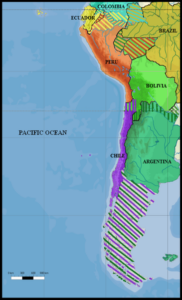 In 1879, as the Pacific war started with Bolivia and Peru (Feb 14, 1879 – Oct 20, 1883), Chile possessed a relatively powerful Navy in south America, punching well above its opponents. Two armoured ships composed the bulk of the fleet, between the two British-built Almirante Cochrane class ironclads (1874), Cochrane and Valparaiso, and soon reinforced by the capture of Huascar from Peru. The rest of the Chilean fleet comprised two old Corvettes, Abtao (1865) and Chacabuco (1866), the protected cruiser Esmeralda (1883) -The previously ordered Arturo Prat was resold to Japan, and the gunboats Magallanes and Philcomayo (182-74).
In 1879, as the Pacific war started with Bolivia and Peru (Feb 14, 1879 – Oct 20, 1883), Chile possessed a relatively powerful Navy in south America, punching well above its opponents. Two armoured ships composed the bulk of the fleet, between the two British-built Almirante Cochrane class ironclads (1874), Cochrane and Valparaiso, and soon reinforced by the capture of Huascar from Peru. The rest of the Chilean fleet comprised two old Corvettes, Abtao (1865) and Chacabuco (1866), the protected cruiser Esmeralda (1883) -The previously ordered Arturo Prat was resold to Japan, and the gunboats Magallanes and Philcomayo (182-74).
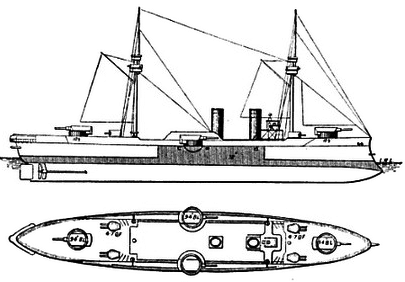 However as tension grew with Argentina about the southern waters of the Cape, the Chilean government at Santiago ordered from France three brand new ships: A battleship (Capital Prat), and two protected cruisers (Pdt. Errazuriz and Pinto). This immediately gave the Armada and egde, and was conversely seen from a very suspicious eye by Bunenos Aires, which feared they would be deployed to reclaim territories in these frigid waters of the far south (see the map, territories revendicated both by Chile and Argentina after 1883).
However as tension grew with Argentina about the southern waters of the Cape, the Chilean government at Santiago ordered from France three brand new ships: A battleship (Capital Prat), and two protected cruisers (Pdt. Errazuriz and Pinto). This immediately gave the Armada and egde, and was conversely seen from a very suspicious eye by Bunenos Aires, which feared they would be deployed to reclaim territories in these frigid waters of the far south (see the map, territories revendicated both by Chile and Argentina after 1883).
Due to the fact Argentina was ordering ships to Britain, a Chilean commission went to France for the same, notably because of the country’s reputation for ship engineering at the time (France was also influencial on the Chilean Army before 1879, seen notably in the uniforms and doctrine – news of the 1870 defeat did not registered yet). An agreement was found in late 1888 with the La Seyne Naval Yard (Forges & Chantiers de la Méditerrannée) at Toulon in France. This was the last of three warships, after the two Cruisers of the Errazuriz class in 1887.
Capitan Prat was ordered 18 April 1889, and laid down soon after.
⚙ The naval Arms Race | |
 Armada de Argentina Armada de Argentina |  Armada de Chile Armada de Chile |
| Libertad class (BB) 1887 Veinticinco de Mayo (PC) 1890 Nueve de Julio (PC) 1891 Buenos Aires (PC) 1894 Garibaldi (AC) 1895 San Martín (AC) 1896 Pueyrredón (AC) 1897 General Belgrano (AC) 1898 Rivadavia, Moreno* (AC) 1901 |
Capitán Prat (BB*) 1887 Presidente Errázuriz (PC) 1887 Presidente Pinto (PC) 1887 Blanco Encalada (PC) 1892 Esmeralda (AC) 1894 Ministro Zenteno (PC) 1894 O'Higgins (AC) 1896 Constitución class (BB) 1901 Chacabuco (PC) 1901 |
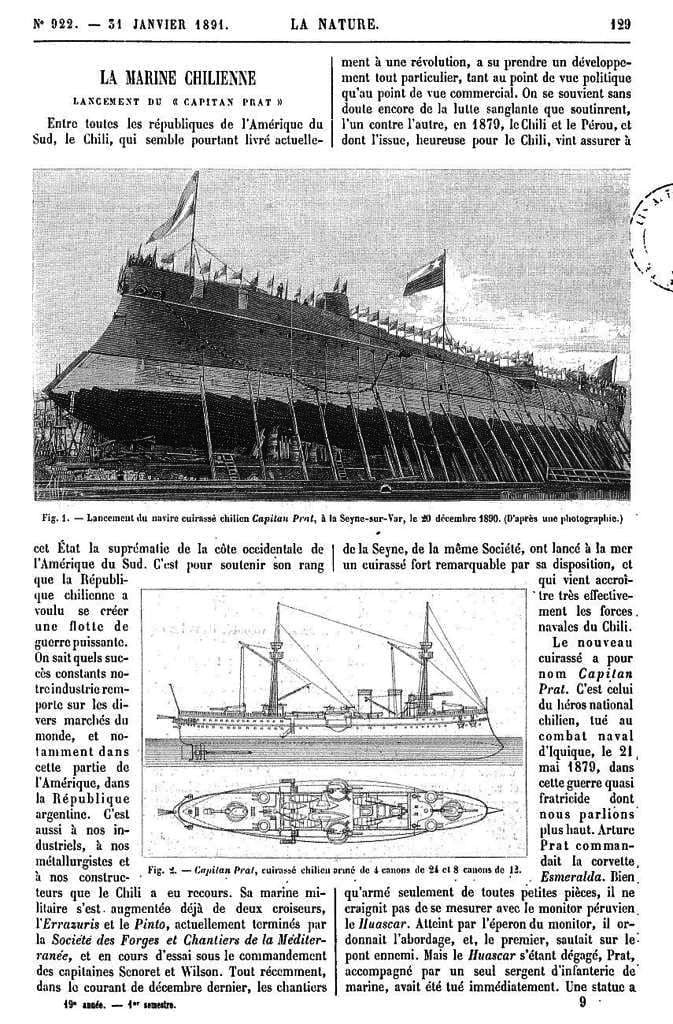
“La Nature” French January 1891 newspaper article about the launch of Capitan Prat.
Design of the class
Capitán Prat was designed by Amable Lagane, director of naval construction at the Forges et Chantiers de la Méditerranée shipyard at La Seyne-sur-Mer. This tailored design later influenced Lagane’s next project, the Jauréguiberry using twin-gun turrets for the secondary battery. She had all the trademarks of typical French ironclads at the time, notably the tumblehome hull, relatively tall, “flush deck” apparent hull with forecastle and poop, battery deck and a full suite of main, secondary, three types of rapid fire light guns and torpedo tubes plus about seven boats for landing parties, including two steam cutters.
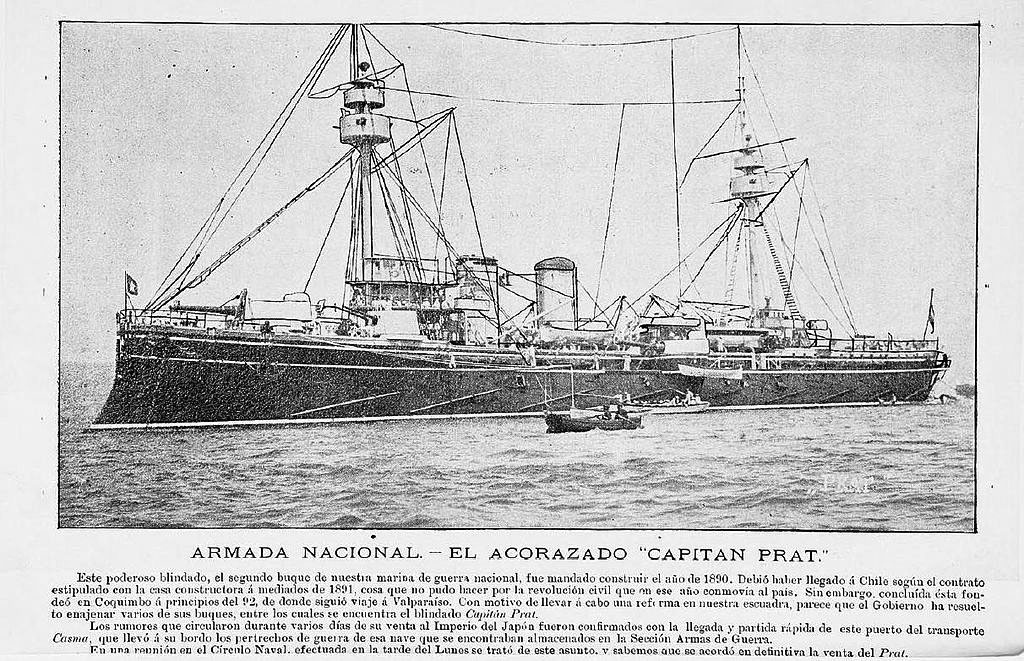
Hull and general design
Capitán Prat was 328 feet (100 m) long between perpendiculars, 60 ft 8 in (18.49 m) in beam. She displaced 6,901 metric tons (6,792 long tons; 7,607 short tons) standard, which was sub-par compared to French ironclads at the time, like the 11,720 long tons (11,910 t), 370 mm armed Formidable. She had a draft of 22 ft 10 in (6.96 m), so all in all a small pre-dreadnought ironclads die to her main armament, inferior to 12-in. Her hull was steel-built with wood and copper sheathing. Like all designs at the time since Lissa, she had a reinforced ram bow. She had two masts with fighting tops and spotting tops above, and a crew of 480 officers and ratings.
Armour protection layout
The Prat’s armor typically was completed with Creusot steel.
-Armored belt 11.8 in (300 mm) amidships above waterline, 7.8 in (200 mm) below WL.
-Upper belt 4.9 in (120 mm) forward, 5.9 in (150 mm) aft.
-Armored Belt, Below Waterline: 3.9 in (99 mm).
-Outer Belt extensions: 2 ft 4 in (0.71 m) above, 4 ft 7 in (1.40 m) below.
-Citadel 3.1 in (79 mm), above machinery spaces amidships.
-Citadel upper deck bulkheads: 3.1 in (79 mm) thick.
-Main deck outside citadel: 2 in (51 mm).
-Main Barbettes 8-10.8 in (200 to 270 mm) fore and aft, sides
-Barbette Hoods: 2 in (51 mm) over the gun crews.
-Conning tower: 10.5 in (270 mm) walls.
Powerplant
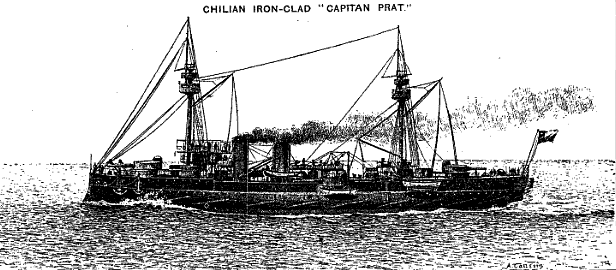
Capital Prat was powered by two horizontal expansion (HE) marine steam engines. They were fed by five cylindrical boilers, trunked into two funnels on the centerline. This powerplant was rated for 12,000 indicated horsepower (8,900 kW). Top speed was 18.3 kn (33.9 km/h; 21.1 mph), reached on trials. She also had 400 t (390 long tons; 440 short tons) of coal in normal condiitions which can be extended with extra filling of void ASW compartments to 1,100 t (1,100 long tons; 1,200 short tons). As said at the start, she was the first battleship (of any navy) to utilize electricity to power machinery, something that was indeed revolutionary at the time and seduced the Chilean commission.
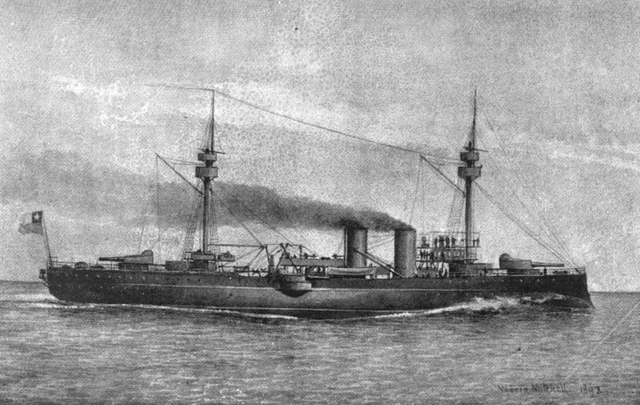
Capitan Prat engraving, likely Brassey’s, steaming out
Armament
Main battery: Four 9.4 in (240 mm)/35 caliber Canet guns, all single turrets. These were electrically powered turrets (this was a first as usually they were steam powered). This means they would be more precisely controlled. The configuration was typically French, with a lozenge pattern: One forward on the centerline, two amidships on sponsons, the last axial, aft of the superstructure. Canet Canon de 240 L Mle 1884 specs: Design Charles Ragon de Bange 1873, manufactured by St. Chamond. Mass 31,000 kg (68,000 lb), barrel 6.7 m (22 ft) L/26, shell 162 kg (357 lb) or 140 kg (310 lb) de Bange Breech with Hydro-gravity recoil, elevation +38°, ROF 1/3 minutes, mv 575 m/s (1,890 ft/s, max range 17.3 km (10.7 mi).
So as seen, if the barbette was faster, the rate of fire was abysmally slow.
Secondary battery: Eight 4.7 in (120 mm) Canet guns: They were placed in four twin turrets mounted on either side of the foremast and mainmast.
These were not De Bange type Modele 1878 but 120/45 Canet M1890 instead, far more capable and long range. No data on these.
Close-range defense:
Against torpedo boats Capitan Prat was provided by six 6-pounder guns, four 3-pounder guns, and ten 1-pounder guns. The first were localized in the wings fore and aft, the 3-pdr guns close by, and the ten 1-pdr distributed between the two fighting tops, possibly five each. They were of the Hotchkiss Type, 57mm/40 Hotchkiss, 47mm/40 Hotchkiss, and 37mm/20 Hotchkiss.
Capitan Prat, as customary at the time, was also armed with four 18 in (460 mm) torpedo tubes. The were placed in deck-mounted launchers, in the bow, stern, and broadsides.
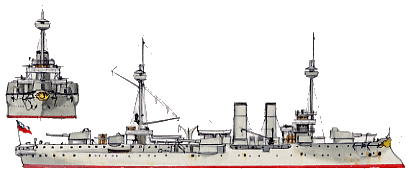
Capitan Prat in 1914. See her in 1894 on shipbucket.
⚙ specifications |
|
| Displacement | 6,901 t (6,792 long tons; 7,607 short tons) standard |
| Dimensions | 328 ft x 60 ft 8 in x 22 ft 10 in (100 x 18.49 x 6.96 m) |
| Propulsion | 2 shafts HE, 5 boilers 12,000 ihp (8,900 kW) |
| Speed | 18.3 kn (33.9 km/h; 21.1 mph) |
| Range | Unknown |
| Armament | 4× 9.4 in, 8× 4.7 in, 6× 6-pdr, 4× 3-pdr, 10× 1-pdr, 4× 18 in TTs |
| Protection | Belt: 11.8 in, Deck 2-3.1 in, CT 10.5 in, Barbettes 10.8 in |
| Crew | 480 |
The long career of Capitan Prat
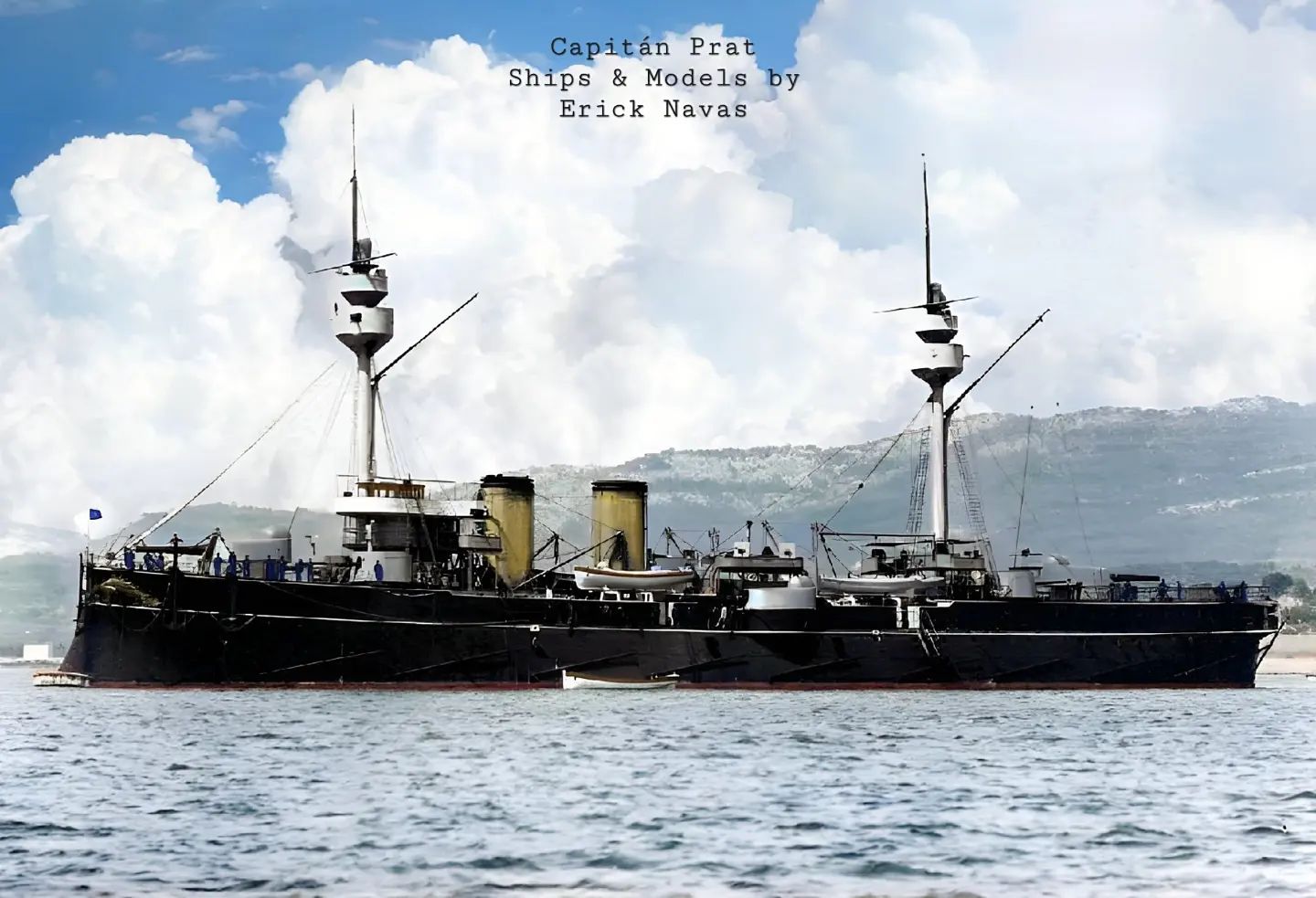
Colorized photo of Capitan Prat by Erick Navas while off La Seyne near Toulon, southern France as built src
On 22 August 1887, the National Congress of Chile passed a law to modernize the fleet, ordering three ships. One was to be a new battleship, completed by two state-of-the art cruisers. Development of the former took longer as it was the largest ship ever constructed for the Chilean Navy. Contract Tender was published and largely advertised throughout Europe, and answered by British, German, and French shipbuilders. But in the end it was wardared to the Société Nouvelle des Forges et Chantiers de la Méditerranée shipyard (FCM) in La Seyne, France, signed on 18 April 1889 for an estimated cost of £391,000, £4,000 less British shipbuilders. She was laid down in 1889, launched on 20 December 1890, commissioned in 1891.
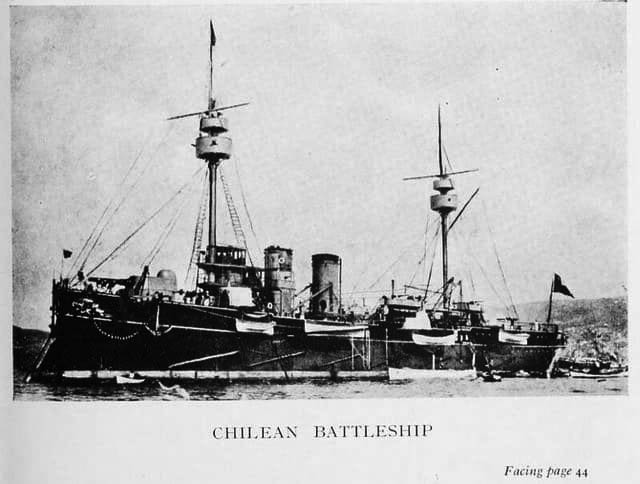
Depiction of the ship by Jane’s
Construction and Consequences
Capitan Prat’s first trip was thus from La Seyne, French Riviera, along the Spanish Mediterranean Coast, through Gibraltar straits and across the Atlantic, then rounding the Cape to Chile, arriving on May 1893. This also served as a shakedown cruise after her yard’s trials and acceptance trials back in France. Word’s critics viewed Capitán Prat in a favorable way, as a prime example of high speed, good armament, good protection and as she arrived, the Government publicized her loudly as the “the most powerful war ship possessed by any South American Nation”, “or any vessel in commission in the United States Navy.” – To the exception of the Brazilian Ironclad Riachuelo (1883), to which she was compared. The latter was however smaller at 5,900 tonnes, and given a rather older configuration of lozenge and twin 9.2-inch (234 mm) gun Coles Turrets, of the 1870s Krupp style guns. Morever, Riachuelo was only capable of 16.7 knots versus 18 or even 19 knots when overheating boilers for the Prat. She was more modern, better armed and protected.
Her apperance, after Riachuelo, really pressed the USN to urge her own naval program, launching USS Texas and USS Maine quickly afterwards (the latter at the same time, but as another response to Riachuelo).
Launching the naval arms race
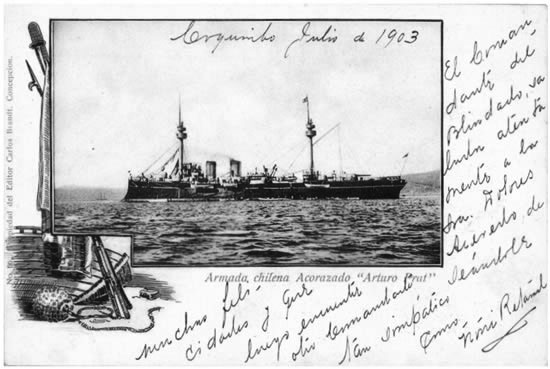
But the most important effect of her arrival was to quickstart a naval arms race between Chile and Argentina. Indeed, two protected cruisers and two torpedo boats also arrived a bit sooner, booting Chile as the prime Navy in South America. Argentina answered with the battleships Independencia and Libertad and the race went on all long the 1890, even after the 1891 Chilean Civil War, but mostl with cruisers, culminating with the Garibaldo class armoured cruisers for the Argentine Navy and Chile ordering two Constitución-class battleships from the United Kingdom. The Pactos de Mayo ended the “folly” and urged to balance both rival’s fleets. This led to the demilitarization of Capitán Prat and two Argentine armored cruisers (later rearmed anyway when a new naval arms race started with Brazil ordering dreadnoughts).
The 1891 Chilean Civil War
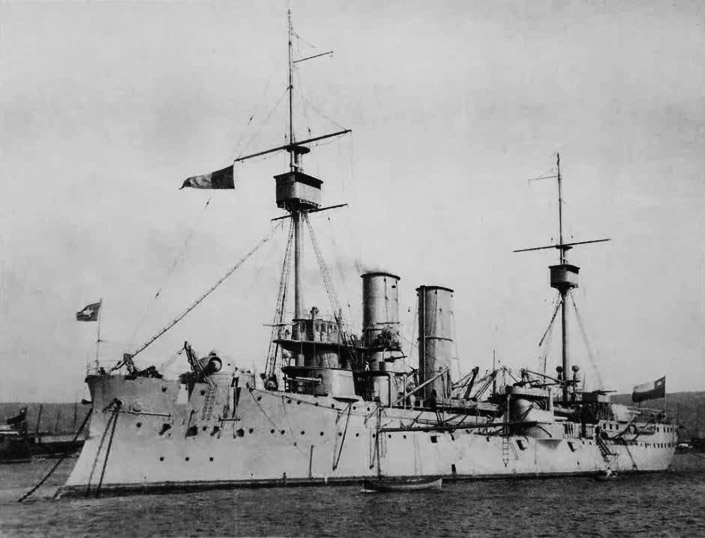
The 1898 war and aftermath
In March 1898, before the Spanish–American War, the US Navy approached the Chilean government to purchase Capitán Prat, in order to bolster its own fleet, weary of the size of the Spanish Armada and in case the latter sent its own ironclads to Cuba. Negotiations however fell through and she remained in Chile.
1903 Japanese purchase attempt
The same scenario repeated itself by 1903, before possible war with Russian over Korea or Port Arthur. The Japanese government again approached Chile for the purchase of this ship, as well as the large protected cruiser Esmeralda (British built, also praised by critics as the world’s most powerful) along with other South American warships. Esmeralda was purchased indeed, commissioned into the Imperial Japanese Navy (IJN) as Izumi, and took part in operations as planned. But Chile retained the Prat, as she was still the fleet’s only capital ship. In 1905 France’s La Seyne Yard also approached the Chilean Government with a proposal of modernization, something they were quite apt, having modernized several Spanish Ironclads and more recently the Pelayo, as old as Prat.
1909-10 Modernization
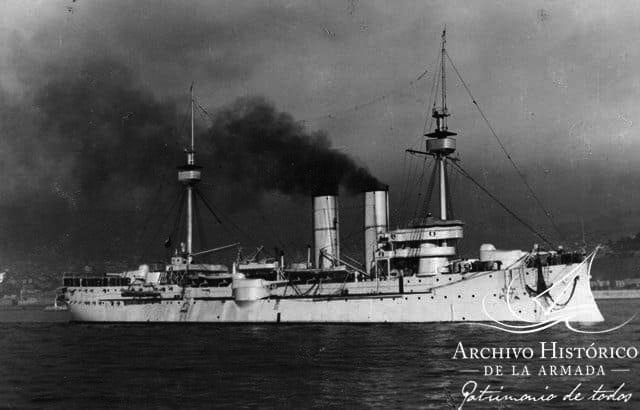
By 1907 this proposal eventually marked a point as a naval commission inspecting the ship reported to the government how outmoded she was in comparison to brand new armored cruisers, notably those built for Argentina. The Pacts of May had seen the Constitution class cancelled and repurchased by the RN, leaving Chile with her as only flagship. In any fight on open sea, she would have been easy meat for the four Argentinian cruisers. So in 1909–1910, Capitan Prat was modernized, but not by France, but Britain, with the installation of twelve brand new Babcock & Wilcox watertube boilers replacing her old cylindrical boilers. As a result she could reach 19.5 kn (22.4 mph; 36.1 km/h) and this necessitated to have her funnels increased in height.
Other modifications included her rebuilt bridge, telemeter installed on its roof, behind the foremast and other detail modifications. Her armament still comprised her main guns, four 47mm/40, ten – 37mm/20 and she onl kept two 450 mm TTs in the bow and stern, but she had the addition of four 57mm/40 Hotchkiss QG guns. It seems this was left unchanged until her disarament and conversion as sub tender (detailed unknown).
See her in 1911 in shipbucket.
Late career (WWI to 1942)
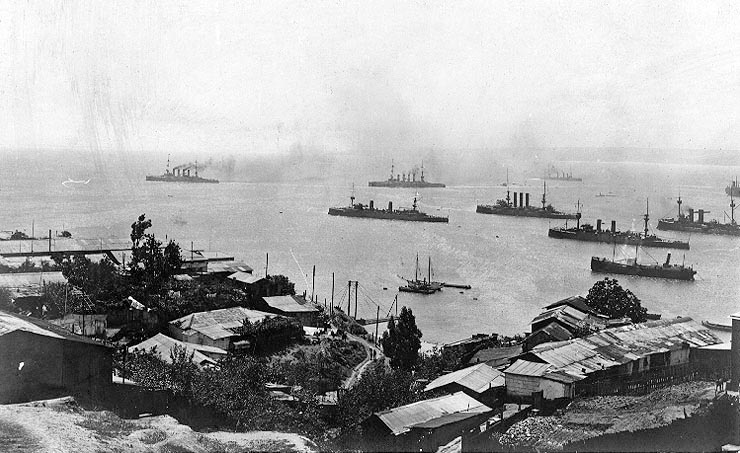
Capitan Prat, present (right lower corner) in Valparaiso when Admiral Graf Spee’s Asian Squadron stopped for coaling in 1914 on his way to the Falklands
On 11 March 1916, Capitán Prat suffered a magazine explosion while anchored in Valparaiso. The enquiry later established that it was cause bt two cases of bad cordite propellant in the aft main battery magazine which degraded to the point of exploding. Thanks to the ship’s construction however, the blast was quickly vented out from the propellant cases, saving the ship from destruction, like the French Battleship Iéna in 1907 for example. This was indeed a 17-20 years old cordite, and it reached its maximum life-span, needed replaceement. However the finances of Chile at the time, and arrival of the super-dreadnought Almirante Latorre quickly saw Prat relegated to coast guard duties.
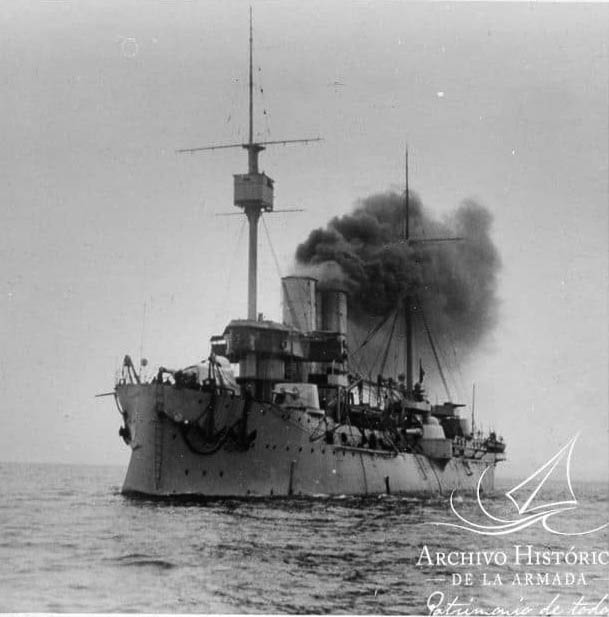
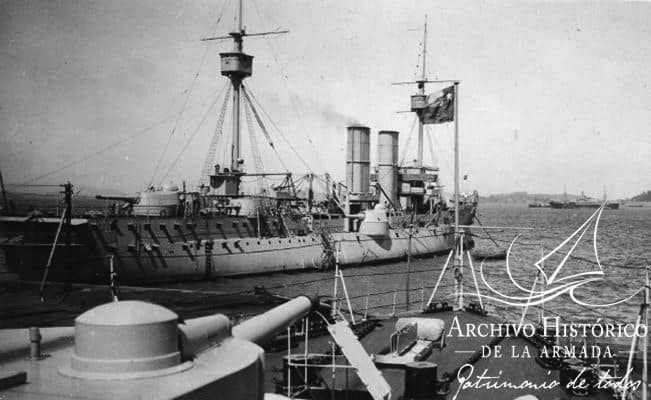
Capitan Prat in the interwar – Archivos Historicos Armada.
In 1926, Capitán Prat was indeed officially reduced as a coast defense ship and in 1928-1930 became a submarine tender for Chilean new submarine fleet, its H-class and Capitan O’Brien-class. After more modern ships for this task were contemplated, she was disarmed in 1935, transformed into a pontoon, and used by the mechanical training school. WW2 went on, the Chile needed money and stell, so she the venerable ironclad was sold for scrap in 1942, not preserved like Huascar.
Read More
Books
Gardiner, Robert, ed. (1979). Conway’s All the World’s Fighting Ships 1860–1905.
Crawford, Steve (2000). Battleships and Carriers. Rochester, NY: Grange.
“Chile”. The Stateman’s Year-Book. New York: Macmillan. 1895. pp. 410–18.
Elliot, George Francis Scott (1907). Chile: its History and Development. New York: Charles Scribner’s Sons.
Garrett, James L. (1985). “The Beagle Channel Dispute: Confrontation and Negotiation in the Southern Cone”. Journal of Interamerican Studies and World Affairs.
Grant, Johnathan A. (2001). Rulers, Guns, and Money: The Global Arms Trade in the Age of Imperialism.
Jordan, John & Caresse, Philippe (2017). French Battleships of World War One. Seaforth Publishing.
Long, John Davis (1903). “The New American Navy”. 2. New York: The Outlook Company.
Marshall, Chris (2007). The Encyclopedia of Ships. Harvard University Press.
Miller, David (2001). The Illustrated Directory of Warships: From 1860 to the Present.
“Naval Notes; A New Chilean Steamer”. Marine Engineer and Naval Architect.
Ropp, Theodore (1987). Roberts, Stephen S. (ed.). The Development of a Modern Navy: French Naval Policy, 1871–1904.
Scheina, Robert L. (1987). Latin America: A Naval History, 1810–1987. NIP
“Treaty of Arbitration Between Argentina and Chile, Signed May 28, 1902″. American Journal of International Law.
The Application of Electricity to Working Ships’ Turrets”. Engineering. 59
Vial (1894). Translated by H. Webster. “Chile”. Journal of the American Society of Naval Engineers.
Links
“Crucero Acorazado Capitán Prat (2do)”. Unidades Navales. Chilean Navy. 2 October 2009.
en.wikipedia.org/
navweaps.com/
http://navypedia.org/ships/chile/chi_bb_capitan_prat.htm
On armada.cl
Marius bar postcard
on militaryfactory.com
on shipsnostalgia.com/
on forum.warthunder.com
Full review of the Capitan Prat in “engineering”

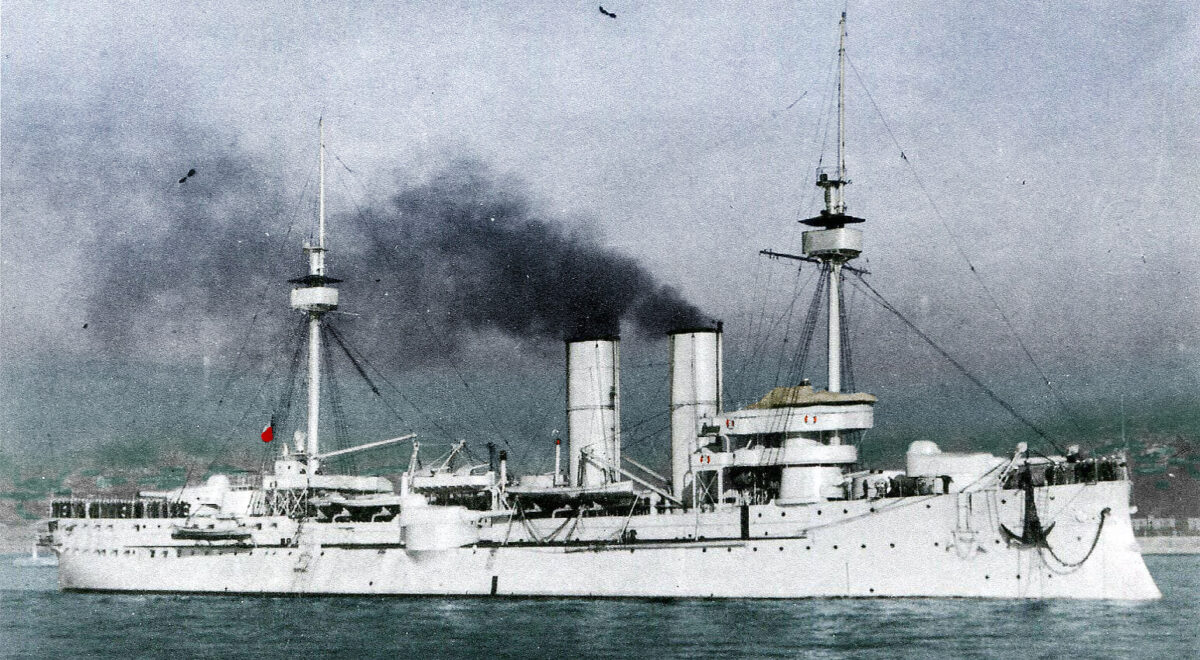

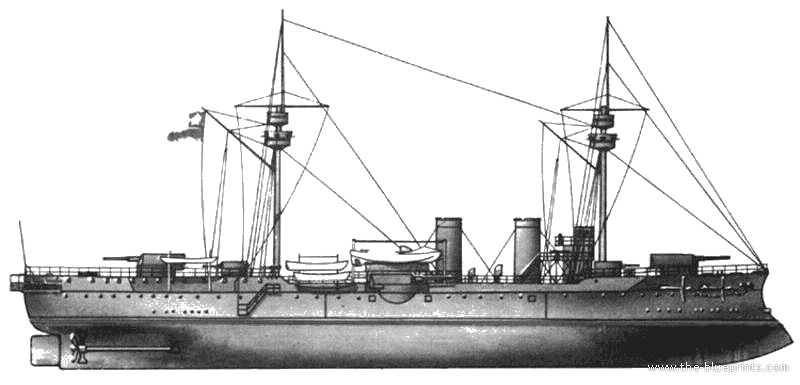
 Latest Facebook Entry -
Latest Facebook Entry -  X(Tweeter) Naval Encyclopedia's deck archive
X(Tweeter) Naval Encyclopedia's deck archive Instagram (@navalencyc)
Instagram (@navalencyc)





 Austrian Navy
Austrian Navy French Navy
French Navy Royal Navy
Royal Navy Armada Espanola
Armada Espanola K.u.K. Kriegsmarine
K.u.K. Kriegsmarine Dansk Marine
Dansk Marine Nautiko Hellenon
Nautiko Hellenon Koninklije Marine 1870
Koninklije Marine 1870 Marinha do Brasil
Marinha do Brasil Osmanlı Donanması
Osmanlı Donanması Marina Do Peru
Marina Do Peru Marinha do Portugal
Marinha do Portugal Regia Marina 1870
Regia Marina 1870 Nihhon Kaigun 1870
Nihhon Kaigun 1870 Preußische Marine 1870
Preußische Marine 1870 Russkiy Flot 1870
Russkiy Flot 1870 Svenska marinen
Svenska marinen Søværnet
Søværnet Union Navy
Union Navy Confederate Navy
Confederate Navy Armada de Argentina
Armada de Argentina Imperial Chinese Navy
Imperial Chinese Navy Marinha do Portugal
Marinha do Portugal Mexico
Mexico Kaiserliche Marine
Kaiserliche Marine 1898 US Navy
1898 US Navy Russkiy Flot
Russkiy Flot French Naval Aviation
French Naval Aviation Russian Naval Aviation
Russian Naval Aviation Sovietskiy Flot
Sovietskiy Flot Royal Canadian Navy
Royal Canadian Navy Royal Australian Navy
Royal Australian Navy RNZN Fleet
RNZN Fleet Chinese Navy 1937
Chinese Navy 1937 Kriegsmarine
Kriegsmarine Chilean Navy
Chilean Navy Danish Navy
Danish Navy Finnish Navy
Finnish Navy Hellenic Navy
Hellenic Navy Polish Navy
Polish Navy Romanian Navy
Romanian Navy Turkish Navy
Turkish Navy Royal Yugoslav Navy
Royal Yugoslav Navy Royal Thai Navy
Royal Thai Navy Minor Navies
Minor Navies Albania
Albania Austria
Austria Belgium
Belgium Columbia
Columbia Costa Rica
Costa Rica Cuba
Cuba Czechoslovakia
Czechoslovakia Dominican Republic
Dominican Republic Haiti
Haiti Hungary
Hungary Honduras
Honduras Estonia
Estonia Iceland
Iceland Eire
Eire Equador
Equador Iran
Iran Iraq
Iraq Latvia
Latvia Liberia
Liberia Lithuania
Lithuania Mandchukuo
Mandchukuo Morocco
Morocco Nicaragua
Nicaragua Persia
Persia San Salvador
San Salvador Sarawak
Sarawak Uruguay
Uruguay Venezuela
Venezuela Zanzibar
Zanzibar Warsaw Pact Navies
Warsaw Pact Navies Bulgaria
Bulgaria Hungary
Hungary

 Bundesmarine
Bundesmarine Dutch Navy
Dutch Navy Hellenic Navy
Hellenic Navy Marina Militare
Marina Militare Taiwanese Navy
Taiwanese Navy Chinese Navy
Chinese Navy Indian Navy
Indian Navy Indonesian Navy
Indonesian Navy JMSDF
JMSDF North Korean Navy
North Korean Navy Philippines Navy
Philippines Navy ROKN
ROKN IDF Navy
IDF Navy Royal New Zealand Navy
Royal New Zealand Navy Egyptian Navy
Egyptian Navy South African Navy
South African Navy

































 RN
RN
 Marine Nationale
Marine Nationale
 Soviet Navy
Soviet Navy
 dbodesign
dbodesign